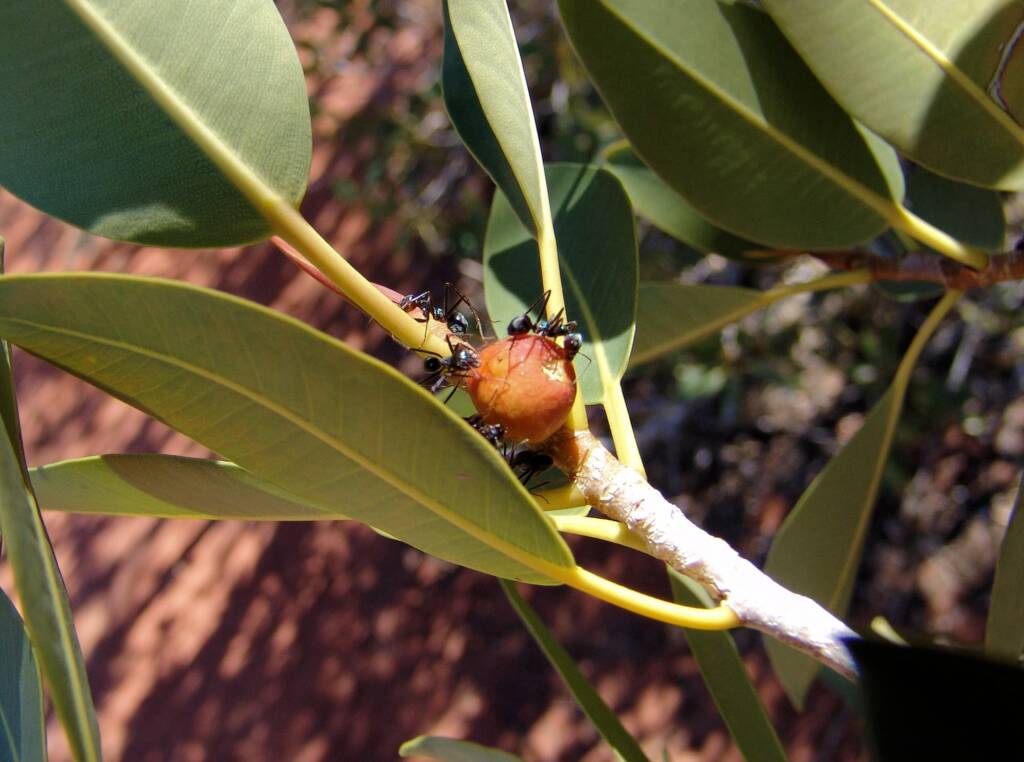The Rock Fig (Ficus platypoda), also commonly known as the Native Fig and the Desert Fig is endemic to central and northern Australia. It is usually found growing on rocky outcrops, reaching up to a height of 10 metres.
The Rock or Native Fig is a spreading shrub or tree up to 8 m in height with smooth pale grey bark, and found growing on or near rock. Usually a tree of the tropic, this species has adapted to dry conditions and are found in gorges and other sheltered areas. The roots of the figs can penetrate half a kilometre into rock crevices in search of moisture. The broad, evergreen leaves have a skin which is glossy on one side, to reflect the sun’s heat, and thick, to cut down water loss by evaporation.
This species consists of plants with various hair types and was previously described under F. platypoda and F. obliqua. Those plants found growing in the arid areas of its range tend to have leaves that are smaller, narrower, thicker and more leathery.
The fruits change from yellow to orange red as they ripen, and can be eaten once ripe and soft.

Native Fig (Ficus platypoda), Palm Valley 
Native Fig (Ficus platypoda), Palm Valley 
Native Fig (Ficus platypoda), Palm Valley 
Native Fig (Ficus platypoda), Palm Valley, Finke Gorge National Park
The fruit of the native fig in Central Australia are an important part of Aboriginal ‘bush food’ diet and such that the trees and where they grow were often regarded as sacred. The figs were were eaten raw or dried and ground into a paste and eaten with water or honey. Early European settlers sometimes gathered the ripe red fruit to make jam.
Figs in Central Australia provide home for up to 14 species of land snails, an animal not commonly seen in the desert. Although Native Figs survive fires and regrow from existing roots, snails are not so lucky, and are killed by the fires. As such, it may take hundreds of years to recolonise a burnt fig, even from nearby figs.
The Rock Fig can be found growing in gorges and rocky escarpment throughout Central Australia, northern parts of Western Australia, the Top End and outback Queensland, especially where there is water, even if it is deep underground.
| CAUTION Extreme care must be taken when identifying edible food plants and those used in bush medicine. Some bush foods are only edible at different stages of the plant cycle, or when treated appropriately. Bush medicine should only be used under the guidance of a qualified physician. Information here is only provided for research. You should always seek experts in the field to confirm the identification of the plant and whether they are edible or appropriate. |
Previously classified under a number of other groupings, including Ficus brachypoda, continual scientific studies have re-classified it under Ficus platypoda.
- Scientific classification
- Kingdom: Plantae
- (unranked): Angiosperms
- (unranked): Eudicots
- (unranked): Rosids
- Order: Rosales
- Family: Moraceae
- Genus: Ficus
- Species: F. platypoda
- Binomial name: Ficus platypoda
Footnote & References
- Wild fig summer treat, 15 December 2010, alice online, www.aliceonline.com.au/wild-fig-tartlets/
